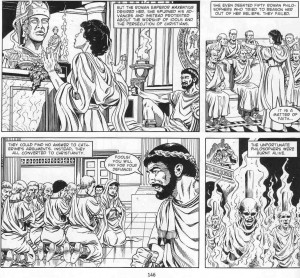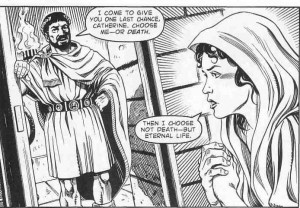I’m continuing my read through the “Big Book of Martyrs,” a collection of short biographies of – you guessed it – martyrs. The comic was written by John Wagner in colloboration with numerous artists. Last week, I read the entry on St. Olaf of Norway, who never behaved like a saint and didn’t actually die as a martyr. For this week, I read about a saint who didn’t persecute pagans, but was instead persecuted by them (assuming she actually existed).
As the legend goes, St. Catherine (early 4th century A.D.) was born into a wealthy family in Alexandria, Egypt. At a young age, she converted to Christianity and declared that she was “married” to the Christ-child. She was attactive enough to catch the eye of the Roman emperor Maxentius, but she rejected his advances. In an effort to win her over, he sent philosophers to convert her back to paganism, but she convinced them to convert to Christianity. This didn’t go over well with Max.
Artwork by Robin Smith
When reason didn’t work, he resorted to brute force and had Catherine flogged. But she still refused to renounce Christ, so Maxentius ordered that she be tortured and killed on a spiked wheel (the exact nature of this device is unknown, but it’s probably similar to the medieval breaking wheel, which is as unpleasant as it sounds).
Before her torture began, angels destroyed the wheel, and 2oo Roman soldiers converted on the spot. Maxentius responded by having them beheaded, and Catherine shared their fate. Milk, not blood, flowed from Catherine’s body, and angels later carried her to the top of Mt. Sinai.
Maxentius eventually got his comeuppance when he was killed by the pro-Christian emperor Constantine at the Battle of the Milvian Bridge.
When comparing St. Catherine to St. Olaf, I immediately noticed how the tales of their martyrdom sacrilized traditional gender roles. Olaf’s claim to sainthood came from his manly actions, particularly his ruthless effort to convert all of Norway to Christianity. His martyrdom also came about from his actions, as he was killed in battle attempting to regain control of Norway from rebellious nobles. Catherine, on the other hand, is a more passive character. Her devotion to Christ comes not from action but from forebearance – she refused to marry or have sex.
Sex is largely irrelevant to Olaf’s martyrdom, but it’s central to Catherine’s story. Or to be more accurate, the explicit lack of sex is central to her story. As with the Virgin Mary, Catherine’s virginity is celebrated as the ultimate virtue for women, a virtue that Catherine is willing to preserve even when facing death. And though she’s a virgin, she’s still married to Christ. This is a marriage based entirely on love and faith rather than the base impulse for sex (which is linked to paganism in the person of Maxentius).
But regardless of the subtext, and regardless of whether or not she actually existed (for the record, I don’t believe she did) Catherine is a compelling figure. In an environment where women were powerless, Catherine defied an emperor, withstood torture, and remained true to her religious principles.




Note that the crowd-pleasing fireworks display the Catherine Wheel was named after her.
That is a freaky looking Christ-child….
Yeah, I wouldn’t recommend magnifying the image – Christ looks like a middle-aged midget. So few artists can draw a decent-looking baby.
Alex-I never knew those spinning fireworks were called Catherine Wheels. This comic is just chock full of useful facts.
It’s kind of in the tradition of medieval Christ imagery though. There is a long illustrious history of Christ as a middle-aged midget….
I remember that from art history class. Artists didn’t understand how infant anatomy differed from adult anatomy.
this is so not true